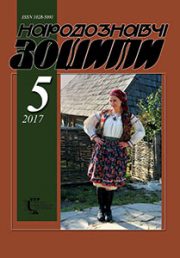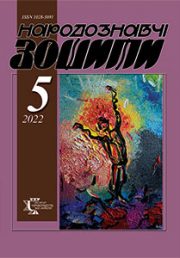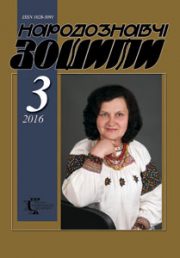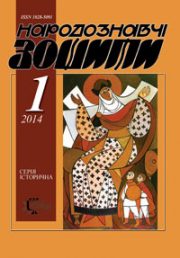The Ethnology Notebooks. 2019, № 5 (149), 1134—1164
UDK 398.332
DOI https://doi.org/10.15407/nz2019.05.1134
POPULAR CALENDAR OF SLAVUTCHYNA IN RITUALS, CUSTOMS AND FOLKLORE
HALAICHUK Volodymyr
ORCID ID: https://orcid.org/0000-0001-7780-5876
Candidate of Philology, docent
The Ivan Franko National University of Lviv
Department of Ethnology
1, Universytetska str., 79000, Lviv, Ukraine
е-mail: halay_czuk@ukr.net
Abstract. The elucidation of the local specificity of certain ethnographic regions today is one of the most important and relevant trends in the study of the traditional culture of Ukrainians. In the research, the author sets himself the goal to comprehensively describe the national calendar of Slavutchyna, which is part of the historical-ethnographic Volhyn. The object of the research is the calendar-marked rites, customs, beliefs and folklore of the settlements of Slavutchyna, and the subject is their all-Ukrainian features, regional and local peculiarities. The methodological basis of the research is the use of basic methods of ethnological science, primarily the method of field ethnography, as well as the development of ethnographers in the field of the laying of national calendars in individual areas. The traditional calendar of Slavutchyna has not been the subject of special studies yet. This aspect is elucidated in the scientific literature quite sparingly, so the basis of the work is the field materials of the author.
The publication describes in detail the register of holidays and dedications, which in the celebration of the Slavutchyna clearly visible folk component.
Among the holidays of winter attracts attention a ritual game with «Kalyta» on Andriʼs day, the custom «Didy» on evening of Melania, «clinging to the Frost» to one of Vilias.
The spring period is accentuated by the customs of «Kolodka» and «The funeral of Savka», confined to the Masnycs, with local representations that Marco Klyuchnik in the spring «disposes of the land». Attracted attention is given to the archaic customs of Provody, walking «roll over in the rye» on Yuri.
Among the holidays of the summer complex, the Rusal Week is the first of all distinguished. As it is typical of the Volhynian and Polissian tradition, a number of rituals, customs and superstitions this week are associated with the notions of mermaids. The peculiarities of local Kupala customs and rituals, accompanied by the production of ritual tree, are noted. Among harvivarian traditions attracts attention the variety of variants with the so-called «beard».
From the autumn dates the local peculiarity is characterized by ideas related to the days of «Miracle» and Exaltation.
Keywords: historically-ethnographic Volhyn, Slavutchyna district, calendar customs and ceremonies, Christmas, Easter, Yuriʼs day, Mermaids week, Kupala, harvest.
Received 5.10.2019
REFERENCES
Koloduk, А. (2017). Calendar rites and songs of middle Volhyn: the state of tradition at the turn of the 20th—21st centuries. In Tradicija ir dabartis (Vol. 12, pp. 213—232). Klaipėda: KU Publishers [in Russian].
Koloduk, А. (2015). Rites and songs of the Kupala-Peter period (Based on the materials of the middle rivers Horyn and Sluch). In Problems of ethnomusicology: Scientific and methodical collection (Issue 10, pp. 104—123). Kyiv [in Ukrainian].
Jankovska, J. (2012). Kupala songs and peculiarities of Ivan Kupala holiday in Slavutchyna (Lysychye village of Slavutsk district of Khmelnytsky region). In Materials on Ukrainian Ethnology (Issue 11, pp. 79—84). Kyiv [in Ukrainian].
Konopka, V., & Zubrovskyi, A. (2018). From Grain to Bread: Semantic-Structural Analysis of Ukrainian Bakery Life (Based on Materials of the Southwestern Historical and Ethnographic Region of Ukraine). Lviv [in Ukrainian].
Pukivskyi, J. (2015). Spring calendar-everyday ritual of Ukrainians of historically-ethnographic Volhyn. Lviv [in Ukrainian].
Nesen, I. (2008). Stork in folk representations of Right-bank Polesie. In Siverian Chronicle (№ 5, pp. 121—127). Czernihiv [in Ukrainian].







